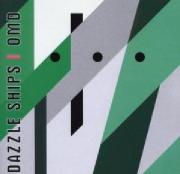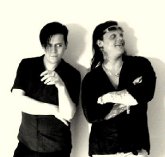Dazzle Ships - Orchestral Manoeuvres In The Dark
1981 had seen success on a global platform for Paul Humphreys and Andy McCluskey with huge sales from their classic album Architecture & Morality and the accompanying singles of Souvenir, Joan of Arc and Maid of Orleans. The world was at their feet, but a swift change in direction was brought about by the dreaded statement of declaration from their record company that if they wrote A&M II then they would have it made and become the 'new' Genesis or Pink Floyd. Not only did he recoil from this idea, but McCluskey was also a bit peeved that critically people were knocking him for not using his new found fame to launch a political message (this was the era of 'Red Wedge' and all that rubbish, remember). So out went the choral chords for a new direction.
Dazzle Ships came at a time when the band discovered the Emulator and thus their early experimental ideas on sampling could now really become a reality and take them up yet another level. Rebelling against mainstream expectation, OMD fell back on their roots and produced an album where sound collages and radio samples sat alongside and were part of the pop songs that came naturally to them.
Dazzle Ships was partially inspired by the legendary art designer Peter Saville who had seen the 1919 painting Dazzle Ships In Drydock At Liverpool by Edward Wadsworth and fancied a crack at some artwork inspired by this painting. He persuaded the dynamic duo to write a track that would not only be the title track of the album but also provide the album with a concept. What it provided was a stunning if fractured piece of art that was critically acclaimed but possibly a step too far for all but dedicated fans of the group.
The themes of this album were both political and followed their scientific homage of earlier works such as Messages and Electricity. This time though, they tackled subjects such as Genetic Engineering and the humble Telegraph. Genetic Engineering was the lead single about a science really in its infancy and a massive change for the group after the atmospheric success they'd had the previous year. With a guitar riff inspired by Brian Eno, the track was littered with samples with a child's Speak 'N Spell toy at the forefront and was argument for the newly emerging science. It was successful enough to break the UK top twenty, but for the main part people were having real trouble associating the sound with the OMD they were more familiar with.
So it was with the album itself. Kicking off with a recording of an East European radio station's call sign, Radio Prague was the first of several experimental sample-laden tracks that were interspersed throughout this album. Not only that, but it was clear to some that the band may have been lacking some ideas for their vision, with the inclusion of old b-sides The Romance of the Telescope and Of All The Things We've Made plus a re-working of pre-OMD track Radio Waves. What they didn't realise at the time, and highlighted by it's inclusion as an extra track on this re-issue, is that second single Telegraph was also a re-working of an old track.
Despite this, Dazzle Ships is an important album for the group and is, for me at least, second only to Architecture & Morality, as my favourite OMD album. The musical collages are an important part of this album and I really don't think it would feel as brilliant without them. OMD were ahead of their time and the likes of Art of Noise, Ultravox and others would experiment with sampling a short while later and make it much more acceptable as an art form or tool within music.
This re-issue reunites the CD version with its proper artwork instead of the blue-tinged facsimile and faithfully recreates the familiar time zones inner sleeve and original credits. Added to the album are a number of extra tracks, the majority of which are either remixes or b-sides. The significant addition is Swiss Radio International, this was part of a theme of using Radio Station call signs for the album and until recently the rights to use this were withheld. It's a short track and, yes, it sounds like an ice cream van jingle, but it's nice to hear it in the place it was always meant to be.
This is not an easy album to listen to for the casual listener but the rewards are there for those who persevere and serve as a valuable reminder in this post-Pop Idol era that experimentation was once a real option for bands at the top of their game.
Superb stuff.
This review originally appeared on www.synthpop.net earlier in 2008




























Your Opinions and Comments
Be the first to post a comment!